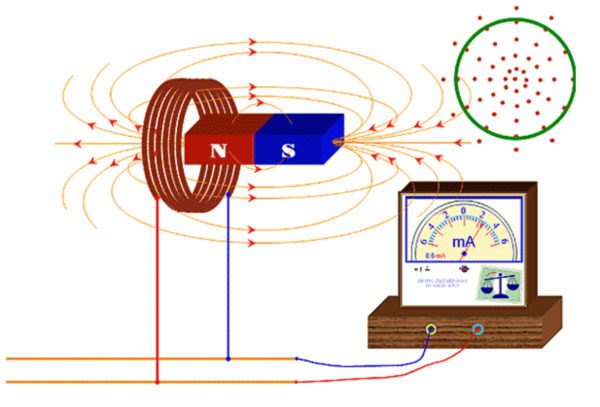The phenomenon of electromagnetic induction is an extremely useful phenomenon with many applications in life. Electromagnetism has created a significant revolution in the field of engineering applications.
Electromagnetic induction is the appearance of an induced current in a closed circuit when the magnetic flux through that circuit varies. The electromotive force generated by the induced current in the closed circuit is called induced electromotive force.
Law of Electromagnetic Induction
The fundamental law of electromagnetic induction states: When there is a change in magnetic flux through the boundary of a closed circuit, an induced electromotive force appears in the circuit.
- Lenz’s Law: The direction of the induced current is such that the magnetic field opposes the cause that produced it.
- Faraday’s Law: The induced electromotive force is the electromotive force generated by the induced current in the closed circuit; it is proportional to the rate of change of magnetic flux through the circuit and inversely proportional to the time duration of that change (that is, it is proportional to the rate of change of magnetic flux).

The phenomenon of electromagnetic induction is an extremely useful phenomenon with many applications.
Applications of Electromagnetic Induction
Electromagnetic induction is an extremely useful phenomenon with many applications in life. Electromagnetism has created a significant revolution in the field of engineering applications. Moreover, it has a substantial impact on other fields such as medicine, industry, and space.
Induction Cooktops
Induction cooktops heat cooking pots through magnetic induction, rather than conducting heat from flames or electric heating elements. Since the induced current directly heats the cooking utensils, the temperature can rise very quickly.
In an induction cooktop, a copper coil is placed beneath an insulating material (usually a ceramic glass cooktop), and an alternating current is passed through this copper coil.
The oscillating magnetic field generates a continuous magnetic flux that magnetizes the pot, and at this moment, the pot acts as the magnetic core of a transformer. This creates large eddy currents (also known as Foucault currents) within the pot. Due to the effect of the Foucault currents, the pot experiences electromagnetic damping forces, which leads to the Joule-Lenz heating effect, warming the bottom of the pot as well as the food inside.
Household Appliances
Electromagnetism serves as the basic working principle of many household appliances such as lights, kitchen devices, air conditioning systems, and more.
Electric Fans
Electric fans and other cooling systems use electric motors. These motors operate based on the principle of electromagnetic induction. In any electrical device, electric motors function due to the magnetic field created by the current according to Lorentz’s force principle. These motors differ only in size and cost based on their applications.
Fluorescent Lamps
The most commonly used lighting systems in homes and commercial buildings are fluorescent lighting systems.
The ballast used in fluorescent lamps operates based on electromagnetic principles; when the lamp is turned on, it generates a high voltage across the two ends of the lamp, causing discharge through the lamp.
The current flowing through the lamp creates ions that act on the phosphor powder, causing the lamp to emit light. (After the lamp lights up, the voltage across the two ends of the lamp decreases, and the current through the lamp is limited by the inductance of the ballast.)
Additionally, there are many applications of electromagnetic induction in household devices such as microwaves, blenders, ovens, doorbells, speakers, etc.
Is Electromagnetic Induction Applicable in Industry?
Generators
Generators use mechanical energy to produce electricity. The “heart” of a generator is a coil within a magnetic field. The operating principle of a generator is that an electric coil rotated at a constant speed within a magnetic field generates alternating current.
Instead of using a rotating coil within a constant magnetic field, there is another way to utilize electromagnetic induction: keeping the coil stationary and rotating a permanent magnet (providing the magnetic field and flux) around the coil.
Medicine
Today, electromagnetic fields play a crucial role in advanced medical devices such as hyperthermia treatment for cancer, implants, and magnetic resonance imaging (MRI).
Maglev Trains
This is one of the modern technologies of transportation systems that utilize the phenomenon of electromagnetic induction. Maglev trains use strong electromagnets to accelerate the train to incredible speeds.
Maglev trains employ the basic principles of magnets such as electromagnetic suspension (EMS) and electrodynamic suspension (EDS). In EMS, the electromagnets used on the train’s body attract it to the iron tracks. These magnets surround the guiding tracks, and the gravitational force between the guides and the magnets lifts the train. In EDS, the train is propelled by the thrust within the guiding tracks through induced currents.





















































